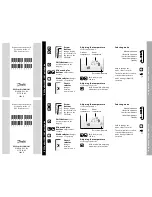
CHAPTER 5: SETTINGS
SYSTEM SETUP
M60 MOTOR PROTECTION SYSTEM – INSTRUCTION MANUAL
5-143
5
The
FREQUENCY AND PHASE REFERENCE
setting determines which signal source is used (and hence which AC signal) for
phase angle reference. The AC signal used is prioritized based on the AC inputs configured for the signal source. Phase
voltages takes precedence, followed by auxiliary voltage, then phase currents, and finally ground current.
For three phase selection, phase A is used for angle referencing (V
ANGLE REF
= V
A
), while Clarke transformation of the phase
signals is used for frequency metering and tracking (V
FREQUENCY
= (2V
A
- V
B
- V
C
) / 3) for better performance during fault,
open pole, and VT and CT fail conditions.
The phase reference and frequency tracking AC signals are selected based upon the source configuration, regardless of
whether or not a particular signal is actually applied to the relay.
Phase angle of the reference signal always displays zero degrees and all other phase angles are relative to this signal. If the
pre-selected reference signal is not measurable at a given time, the phase angles are not referenced.
The phase angle referencing is done via a phase locked loop, which can synchronize independent UR-series relays if they
have the same AC signal reference. This results in very precise correlation of phase angle indications between different UR-
series relays.
FREQUENCY TRACKING
is set to “Disabled” only in unusual circumstances; consult GE Grid Solutions for special variable-
frequency applications.
5.5.3 Signal sources
SETTINGS
SYSTEM SETUP
SIGNAL SOURCES
SOURCE 1(4)
Identical menus are available for each source. The "SRC 1" text can be replaced by with a user-defined name appropriate
for the associated source.
The first letter in the source identifier represents the module slot position. The number directly following this letter
represents either the first bank of four channels (1, 2, 3, 4) called “1” or the second bank of four channels (5, 6, 7, 8) called
“5” in a particular CT/VT module. See the Introduction to AC Sources section at the beginning of this chapter for details.
It is possible to select the sum of all CT combinations. The first channel displayed is the CT to which all others are referred.
For example, the selection “F1+F5” indicates the sum of each phase from channels “F1” and “F5,” scaled to whichever CT
has the higher ratio. Selecting “None” hides the associated actual values.
The approach used to configure the AC sources consists of several steps; first step is to specify the information about each
CT and VT input. For CT inputs, this is the nominal primary and secondary current. For VTs, this is the connection type, ratio
and nominal secondary voltage. Once the inputs have been specified, the configuration for each source is entered,
including specifying which CTs are summed together.
The frequency tracking feature functions only when the M60 is in the “Programmed” mode. If the M60 is “Not
Programmed,” then metering values are available but can exhibit significant errors.
SOURCE 1
SOURCE 1 NAME:
SRC 1
Range: up to 20 alphanumeric characters
SOURCE 1 PHASE CT:
None
Range: None, F1,... up to any 6 CTs. Only Phase CT
inputs are displayed.
SOURCE 1 GROUND CT:
None
Range: None, F1,... up to any 6 CTs. Only Ground CT
inputs are displayed.
SOURCE 1 PHASE VT:
None
Range: None, F5, M5
Only phase voltage inputs are displayed
SOURCE 1 AUX VT:
None
Range: None, F5, M5
Only auxiliary voltage inputs are displayed
Summary of Contents for M60
Page 9: ...TABLE OF CONTENTS M60 MOTOR PROTECTION SYSTEM INSTRUCTION MANUAL ix INDEX ...
Page 10: ...x M60 MOTOR PROTECTION SYSTEM INSTRUCTION MANUAL TABLE OF CONTENTS ...
Page 552: ...5 344 M60 MOTOR PROTECTION SYSTEM INSTRUCTION MANUAL TESTING CHAPTER 5 SETTINGS 5 ...
Page 660: ...iv M60 MOTOR PROTECTION SYSTEM INSTRUCTION MANUAL ABBREVIATIONS ...
















































